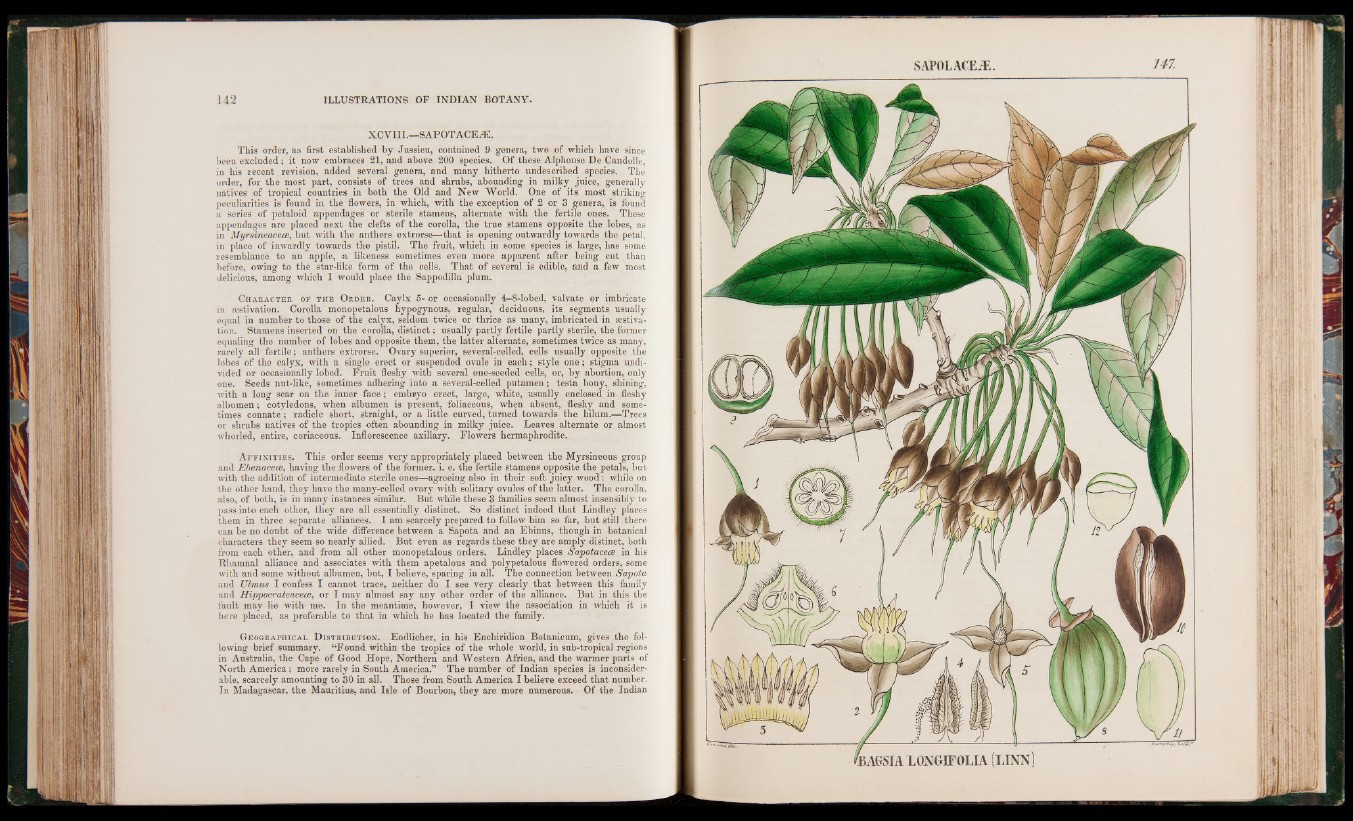
XCVIII.—SAPOTACEiE.
This order, as first established by Jussieu, contained 9 genera, two of which have since
been excluded; it now embraces 21, and above 200 species. Of these Alphonse De Candolle,
in his recent revision, added several genera, and many hitherto undescribed species. The
order, for the most part, consists of trees and shrubs, abounding in milky juice, generally
natives of tropical countries in both the Old and New World. One of its most striking
peculiarities is found in the flowers, in which, with the exception of 2 or 3 genera, is found
a series of petaloid appendages or sterile stamens, alternate with the fertile ones. These
appendages are placed next the clefts of the corolla, the true stamens opposite the lobes, as
in Myrsineacece, but with the anthers extrorse—that is opening outwardly towards the petal,
in place of inwardly towards the pistil. The fruit, which in some species is large, has some
resemblance to an apple, a likeness sometimes even more apparent after being cut than
before, owing to the star-like form of the cells. That of several is edible, and a few most
delicious, among which I would place the Sappodilla plum.
Character of the Order. Caylx 5- or occasionally 4-8-lobed, valvate or imbricate
in aestivation. Corolla monopetalous hypogynous, regular, deciduous, its segments usually
equal in number to those of the calyx, seldom twice or thrice as many, imbricated in aestivation.
Stamens inserted on the corolla, distinct; usually partly fertile partly sterile, the former
equaling the number of lobes and opposite them, the latter alternate, sometimes twice as many,
rarely all fertile; anthers extrorse. Ovary superior, several-celled, cells usually opposite the
lobes of the calyx, with a single erect or suspended ovule in each; style one; stigma undivided
or occasionally lobed. Fruit fleshy with several one-seeded cells, or, by abortion, only
one. Seeds nut-like, sometimes adhering into a several-celled putamen; testa bony, shining,
with a long scar on the inner face; embryo erect, large, white, usually enclosed in fleshy
albumen; cotyledons, when albumen is present, foliaceous, when absent, fleshy and sometimes
connate; radicle short, straight, or a little curved, turned towards the hilum.—Trees
or shrubs natives of the tropics often abounding in milky juice. Leaves alternate or almost
whorled, entire, coriaceous. Inflorescence axillary. Flowers hermaphrodite.
Af f in it ie s . This order seems very appropriately placed between the Myrsineous group
and Ebenacece, having the flowers of the former, i. e. the fertile stamens opposite the petals, but
with the addition of intermediate sterile ones—agreeing also in their soft juicy wood: while on
the other hand, they have the many-celled ovary with solitary ovules of the latter. The corolla,
also, of both, is in many instances similar. But while these 3 families seem almost insensibly to
pass into each other, they are all essentially distinct. So distinct indeed that Lindley places
them in three separate alliances. I am scarcely prepared to follow him so far, but still there
can be no doubt of the wide difference between a Sapota and an Ebinus, though in botanical
characters they seem so nearly allied. But even as regards these they are amply distinct, both
from each other, and from all other monopetalous orders. Lindley places Sapotacece in his
Rhamnal alliance and associates with them apetalous and polypetalous flowered orders, some
with and some without albumen, but, I believe, sparing in all. The connection between Sapota
and Ulmus I confess I cannot trace, neither do I see very clearly that between this family
and Hippocrateacece, or I may almost say any other order of the alliance. But in this the
fault may lie with me. In the meantime, however, I view the association in which it is
here placed, as preferable to that in which he has located the family.
Geographical D istribution. Endlicher, in his Enchiridion Botanicum, gives the following
brief summary. “Found within the tropics of the whole world, in sub-tropical regions
in Australia, the Cape of Good Hope, Northern and Western Africa, and the warmer parts of
North America; more rarely in South America.” The number of Indian species is inconsiderable,
scarcely amounting to 30 in all. Those from South America I believe exceed that number.
In Madagascar, the Mauritius) and Isle of Bourbon, they are more numerous. Of the Indian